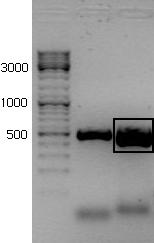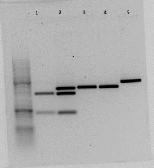Team:NTNU Trondheim/rrnB
From 2011.igem.org
m (→rrnB P1) |
m (→rrnB P1) |
||
| Line 26: | Line 26: | ||
'''proL.rev:''' GTTTCTTCCTGCAGCGGCCGCTACTAGTAGCGGCGTGTTTGCCGTTGTT | '''proL.rev:''' GTTTCTTCCTGCAGCGGCCGCTACTAGTAGCGGCGTGTTTGCCGTTGTT | ||
| + | |||
| + | The nucleotide sequences of both PCR products are given below: | ||
| + | |||
| + | [[Media:rrnB P1 sequence.txt| Nucleotide sequence of rrnB P1 biobrick]] | ||
| + | |||
| + | [[Media:proL sequence.txt| Nucleotide sequence of proL biobrick]] | ||
| Line 35: | Line 41: | ||
The promoter was characterized using a construct consisting of rrnB P1, LacZ, pBad and relA. pBad is an inducable promoter that gets upregulated in response to the presence of arabinose. relA was set under control of the pBad promoter. When the promoter got upregulated due to arabinose, relA would be transcribed, resulting in ppGpp. To see if ppGpp really downregulates the rrnB P1 promoter, this promoter was coupled to the LacZ gene. LacZ codes for β-lactamase, which is capable of cleaving ONPG, yielding a yellow color. For the results of the caracterization, see the [https://2011.igem.org/Team:NTNU_Trondheim/Characterization characterization page]. | The promoter was characterized using a construct consisting of rrnB P1, LacZ, pBad and relA. pBad is an inducable promoter that gets upregulated in response to the presence of arabinose. relA was set under control of the pBad promoter. When the promoter got upregulated due to arabinose, relA would be transcribed, resulting in ppGpp. To see if ppGpp really downregulates the rrnB P1 promoter, this promoter was coupled to the LacZ gene. LacZ codes for β-lactamase, which is capable of cleaving ONPG, yielding a yellow color. For the results of the caracterization, see the [https://2011.igem.org/Team:NTNU_Trondheim/Characterization characterization page]. | ||
| - | |||
| - | |||
| - | |||
| - | |||
| - | |||
| - | |||
| - | |||
Revision as of 11:28, 26 August 2011

rrnB P1
Previous studies have shown that the rrnB P1 promoter is downregulated by ppGpp[1]. That is why we decided to use this promoter as the stress sensing promoter in the stress sensor. A version of rrnB P1 already existed in the Registry of Standard Biological Parts. This version was made by the Berkeley iGEM team in 2008.
The BioBrick that the Berkeley team made is in [http://openwetware.org/wiki/Template:AndersonLab:BBb_Standard BBb format]. This means that the BioBrick is flanked by a prefix and a suffix that is different from the ones that are normally used. Therefore, this BioBrick was initially not compatible with the other BioBricks we were planning to use in our construct, as all the other BioBricks we planned to use were in BBa format.
To deal with this problem, the rrnB P1 promoter was amplified using PCR. The original promoter made by the Berkeley iGEM team was used as template DNA. To make the amplified brick compatible with the rest of our construct, the [http://partsregistry.org/Help:BioBrick_Prefix_and_Suffix standard prefix and suffix] was added to our primers.
When we amplified the promoter, we amplified both the whole brick (rrnB P1) and only the assumed promoter sequence (proL). Primers for both amplifications are given below:
rrnB P1.fwd: GTTTCTTCGAATTCGCGGCCGCTTCTAGAGACGTATCCTACGCCCGTGGT
rrnB P1.rev: GTTTCTTCCTGCAGCGGCCGCTACTAGTACGCCTTCCCGCTACAGAGTCA
proL.fwd: GTTTCTTCGAATTCGCGGCCGCTTCTAGAGCCTCTTGTCAGGCCGGAATAACTCC
proL.rev: GTTTCTTCCTGCAGCGGCCGCTACTAGTAGCGGCGTGTTTGCCGTTGTT
The nucleotide sequences of both PCR products are given below:
Nucleotide sequence of rrnB P1 biobrick
Nucleotide sequence of proL biobrick
The PCR-product was run on a 1,5% agarose gel in order to verify that we had achieved the correct product and to separate it from any other unwanted products.
The new rrnB P1 biobrick was inserted in the psb1C3 plasmid provided by the iGem HQ. Plasmid from five colonies were digested with the enzymes BstBI and SpeI It seems like parallel 1 and 2 have the insert.
The promoter was characterized using a construct consisting of rrnB P1, LacZ, pBad and relA. pBad is an inducable promoter that gets upregulated in response to the presence of arabinose. relA was set under control of the pBad promoter. When the promoter got upregulated due to arabinose, relA would be transcribed, resulting in ppGpp. To see if ppGpp really downregulates the rrnB P1 promoter, this promoter was coupled to the LacZ gene. LacZ codes for β-lactamase, which is capable of cleaving ONPG, yielding a yellow color. For the results of the caracterization, see the characterization page.
[1] Magnusson, Lisa U., Farewell, Anne, Nyström, Thomas: "ppGpp: a global regulator in Escherichia Coli", 2005
 "
"





